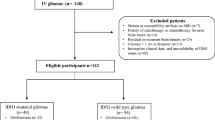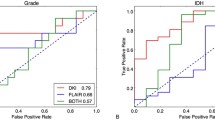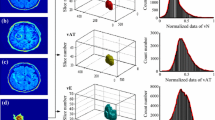Abstract
Preoperative prediction of molecular information of lower-grade gliomas (LrGGs) helps to determine the overall treatment strategy as well as the initial surgical strategy. This study aimed to detect magnetic resonance imaging (MRI) texture parameters to predict the molecular signature of LrGGs using a commercially available software and routine MR images. Forty-three patients treated at Keio University Hospital who had World Health Organization grade II or III gliomas were included. All patients having preoperative T1- and T2-weighted, fluid-attenuated inversion recovery (FLAIR) and diffusion-weighted (DW) images were also included. Texture analyses of T2, FLAIR, and apparent diffusion coefficient (ADC) histograms were performed using a commercially available software. Texture parameters including kurtosis, skewness, and entropy were investigated to determine any correlation with the presence or absence of isocitrate dehydrogenase (IDH) mutations, 1p/19q codeletion, and O6-methylguanine-DNA methyltransferase (MGMT) promoter methylation. ADC skewness and T2 skewness were significantly associated with 1p/19q codeletion status. ADC skewness of ≥ 0.25 predicted 1p/19q codeletion with a sensitivity and specificity of 80% and 65.2%, respectively (AUC = 0.728). T2 skewness of ≥ − 0.11 predicted 1p/19q codeletion with a sensitivity and specificity of 80% and 91.3%, respectively, (AUC = 0.866). None of the texture parameters were associated with IDH mutation and MGMT promoter methylation. MRI texture analysis using a commercially available software demonstrated that T2 skewness could predict 1p/19q codeletion with high sensitivity and specificity, suggesting a clinical utility.


Similar content being viewed by others
References
Akkus Z, Ali I, Sedlar J, Agrawal JP, Parney IF, Giannini C, Erickson BJ (2017) Predicting deletion of chromosomal arms 1p/19q in low-grade gliomas from MR images using machine intelligence. J Digit Imaging 30:469–476. https://doi.org/10.1007/s10278-017-9984-3
Arvinda HR, Kesavadas C, Sarma PS, Thomas B, Radhakrishnan VV, Gupta AK, Kapilamoorthy TR, Nair S (2009) Glioma grading: sensitivity, specificity, positive and negative predictive values of diffusion and perfusion imaging. J Neuro-Oncol 94:87–96. https://doi.org/10.1007/s11060-009-9807-6
Batchala PP, Muttikkal TJE (2019) Neuroimaging-based classification algorithm for predicting 1p/19q-codeletion status in IDH-mutant lower grade gliomas. AJNR Am J Neuroradiol 40:426–432. https://doi.org/10.3174/ajnr.A5957
Blonski M, Taillandier L, Herbet G, Maldonado IL, Beauchesne P, Fabbro M, Campello C, Goze C, Rigau V, Moritz-Gasser S, Kerr C, Ruda R, Soffietti R, Bauchet L, Duffau H (2012) Combination of neoadjuvant chemotherapy followed by surgical resection as a new strategy for WHO grade II gliomas: a study of cognitive status and quality of life. J Neuro-Oncol 106:353–366. https://doi.org/10.1007/s11060-011-0670-x
Blonski M, Pallud J, Goze C, Mandonnet E, Rigau V, Bauchet L, Fabbro M, Beauchesne P, Baron MH, Fontaine D, Peruzzi P, Darlix A, Duffau H, Taillandier L (2013) Neoadjuvant chemotherapy may optimize the extent of resection of World Health Organization grade II gliomas: a case series of 17 patients. J Neuro-Oncol 113:267–275. https://doi.org/10.1007/s11060-013-1106-6
Brat DJ, Verhaak RG, Aldape KD, Yung WK, Salama SR et al (2015) Comprehensive, integrative genomic analysis of diffuse lower-grade gliomas. N Engl J Med 372:2481–2498. https://doi.org/10.1056/NEJMoa1402121
Broen MPG, Smits M, Wijnenga MMJ, Dubbink HJ, Anten M, Schijns O, Beckervordersandforth J, Postma AA, van den Bent MJ (2018) The T2-FLAIR mismatch sign as an imaging marker for non-enhancing IDH-mutant, 1p/19q-intact lower-grade glioma: a validation study. Neuro-Oncology 20:1393–1399. https://doi.org/10.1093/neuonc/noy048
Brown R, Zlatescu M, Sijben A, Roldan G, Easaw J, Forsyth P, Parney I, Sevick R, Yan E, Demetrick D, Schiff D, Cairncross G, Mitchell R (2008) The use of magnetic resonance imaging to noninvasively detect genetic signatures in oligodendroglioma. Clin Cancer Res 14:2357–2362. https://doi.org/10.1158/1078-0432.ccr-07-1964
Caverzasi E, Papinutto N, Castellano A, Zhu AH, Scifo P, Riva M, Bello L, Falini A, Bharatha A, Henry RG (2016) Neurite orientation dispersion and density imaging color maps to characterize brain diffusion in neurologic disorders. J Neuroimaging 26:494–498. https://doi.org/10.1111/jon.12359
Chang P, Grinband J, Weinberg BD, Bardis M, Khy M, Cadena G, Su MY, Cha S, Filippi CG, Bota D, Baldi P, Poisson LM, Jain R, Chow D (2018) Deep-learning convolutional neural networks accurately classify genetic mutations in gliomas. AJNR Am J Neuroradiol 39:1201–1207. https://doi.org/10.3174/ajnr.A5667
de Perrot T, Lenoir V (2017) Apparent diffusion coefficient histograms of human papillomavirus-positive and human papillomavirus-negative head and neck squamous cell carcinoma: assessment of tumor heterogeneity and comparison with histopathology. AJNR Am J Neuroradiol 38:2153–2160. https://doi.org/10.3174/ajnr.A5370
Eckel-Passow JE, Lachance DH, Molinaro AM, Walsh KM, Decker PA et al (2015) Glioma groups based on 1p/19q, IDH, and TERT promoter mutations in tumors. N Engl J Med 372:2499–2508. https://doi.org/10.1056/NEJMoa1407279
Ellingson BM, Sahebjam S, Kim HJ, Pope WB, Harris RJ, Woodworth DC, Lai A, Nghiemphu PL, Mason WP, Cloughesy TF (2014) Pretreatment ADC histogram analysis is a predictive imaging biomarker for bevacizumab treatment but not chemotherapy in recurrent glioblastoma. AJNR Am J Neuroradiol 35:673–679. https://doi.org/10.3174/ajnr.A3748
Ellingson BM, Gerstner ER, Smits M, Huang RY, Colen R et al (2017) Diffusion MRI phenotypes predict overall survival benefit from anti-VEGF monotherapy in recurrent glioblastoma: converging evidence from phase II trials. Clin Cancer Res 23:5745–5756. https://doi.org/10.1158/1078-0432.ccr-16-2844
Ezaki T, Sasaki H, Hirose Y, Miwa T, Yoshida K, Kawase T (2011) Molecular characteristics of pediatric non-ependymal, nonpilocytic gliomas associated with resistance to temozolomide. Mol Med Rep 4:1101–1105. https://doi.org/10.3892/mmr.2011.573
Figini M, Riva M, Graham M, Castelli GM, Fernandes B, Grimaldi M, Baselli G, Pessina F, Bello L, Zhang H, Bizzi A (2018) Prediction of isocitrate dehydrogenase genotype in brain gliomas with mri: single-shell versus multishell diffusion models. Radiology 289:788–796. https://doi.org/10.1148/radiol.2018180054
Hayashi S, Sasaki H, Kimura T, Abe T, Nakamura T, Kitamura Y, Miwa T, Kameyama K, Hirose Y, Yoshida K (2015) Molecular-genetic and clinical characteristics of gliomas with astrocytic appearance and total 1p19q loss in a single institutional consecutive cohort. Oncotarget 6:15871–15,881. https://doi.org/10.18632/oncotarget.3869
Hayashi S, Kitamura Y, Hirose Y, Yoshida K, Sasaki H (2017) Molecular-genetic and clinicopathological prognostic factors in patients with gliomas showing total 1p19q loss: gain of chromosome 19p and histological grade III negatively correlate with patient’s prognosis. J Neuro-Oncol 132:119–126. https://doi.org/10.1007/s11060-016-2344-1
Hirose Y, Aldape K, Takahashi M, Berger MS, Feuerstein BG (2001) Tissue microdissection and degenerate oligonucleotide primed-polymerase chain reaction (DOP-PCR) is an effective method to analyze genetic aberrations in invasive tumors. J Mol Diagn 3:62–67. https://doi.org/10.1016/s1525-1578(10)60653-8
Iwadate Y, Shinozaki N, Matsutani T, Uchino Y, Saeki N (2016) Molecular imaging of 1p/19q deletion in oligodendroglial tumours with 11C-methionine positron emission tomography. J Neurol Neurosurg Psychiatry 87:1016–1021. https://doi.org/10.1136/jnnp-2015-311,516
Jakola AS, Zhang YH, Skjulsvik AJ, Solheim O, Bo HK, Berntsen EM, Reinertsen I, Gulati S, Forander P, Brismar TB (2018) Quantitative texture analysis in the prediction of IDH status in low-grade gliomas. Clin Neurol Neurosurg 164:114–120. https://doi.org/10.1016/j.clineuro.2017.12.007
Jenkins RB, Blair H, Ballman KV, Giannini C, Arusell RM, Law M, Flynn H, Passe S, Felten S, Brown PD, Shaw EG, Buckner JC (2006) A t(1;19)(q10;p10) mediates the combined deletions of 1p and 19q and predicts a better prognosis of patients with oligodendroglioma. Cancer Res 66:9852–9861. https://doi.org/10.1158/0008-5472.can-06-1796
Jenkinson MD, Smith TS, Joyce KA, Fildes D, Broome J, du Plessis DG, Haylock B, Husband DJ, Warnke PC, Walker C (2006) Cerebral blood volume, genotype and chemosensitivity in oligodendroglial tumours. Neuroradiology 48:703–713. https://doi.org/10.1007/s00234-006-0122-z
Kanazawa T, Fujiwara H, Takahashi H, Nishiyama Y, Hirose Y, Tanaka S, Yoshida K, Sasaki H (2018) Imaging scoring systems for preoperative molecular diagnoses of lower-grade gliomas. Neurosurg Rev. https://doi.org/10.1007/s10143-018-0981-x
Kang Y, Choi SH, Kim YJ, Kim KG, Sohn CH, Kim JH, Yun TJ, Chang KH (2011) Gliomas: histogram analysis of apparent diffusion coefficient maps with standard- or high-b-value diffusion-weighted MR imaging--correlation with tumor grade. Radiology 261:882–890. https://doi.org/10.1148/radiol.11110686
Kim JH, Ko ES, Lim Y, Lee KS, Han BK, Ko EY, Hahn SY, Nam SJ (2017) Breast cancer heterogeneity: MR imaging texture analysis and survival outcomes. Radiology 282:665–675. https://doi.org/10.1148/radiol.2016160261
Kinoshita M, Sakai M, Arita H, Shofuda T, Chiba Y, Kagawa N, Watanabe Y, Hashimoto N, Fujimoto Y, Yoshimine T, Nakanishi K, Kanemura Y (2016) Introduction of high throughput magnetic resonance T2-weighted image texture analysis for WHO grade 2 and 3 gliomas. PLoS One 11:e0164268. https://doi.org/10.1371/journal.pone.0164268
Kitamura Y, Sasaki H, Kimura T, Miwa T, Takahashi S, Kawase T, Yoshida K (2013) Molecular and clinical risk factors for recurrence of skull base chordomas: gain on chromosome 2p, expression of brachyury, and lack of irradiation negatively correlate with patient prognosis. J Neuropathol Exp Neurol 72:816–823. https://doi.org/10.1097/NEN.0b013e3182a065d0
Kleihues P, Cavanee W (2000) Pathology and genetics of tumors of the nervous system. International Agency for Research on Cancer Press, Lyon
Korfiatis P, Kline TL, Coufalova L, Lachance DH, Parney IF, Carter RE, Buckner JC, Erickson BJ (2016) MRI texture features as biomarkers to predict MGMT methylation status in glioblastomas. Med Phys 43:2835–2844. https://doi.org/10.1118/1.4948668
Levner I, Drabycz S, Roldan G, De Robles P, Cairncross JG, Mitchell R (2009) Predicting MGMT methylation status of glioblastomas from MRI texture. Medical image computing and computer-assisted intervention: MICCAI International Conference on Medical Image Computing and Computer-Assisted Intervention 12:522–530
Louis DN, Ohgaki H, Wiestler OD, Cavenee WK (2007) WHO classification of tumours of the central nervous system, 4th edn. International Agency for Research on Cancer, Lyon
Louis DN, Ohgaki H, Wiestler OD, Cavenee WK, Ellison DW, Figarella-Branger D, Perry A, Reifenberger G, von Deimling A (2016) WHO classification of tumours of the central nervous system. Revised 4th Edition edn. International Agency for Research on Cancer, Lyon
Megyesi JF, Kachur E, Lee DH, Zlatescu MC, Betensky RA, Forsyth PA, Okada Y, Sasaki H, Mizoguchi M, Louis DN, Cairncross JG (2004) Imaging correlates of molecular signatures in oligodendrogliomas. Clin Cancer Res 10:4303–4306. https://doi.org/10.1158/1078-0432.ccr-04-0209
Olar A, Wani KM, Alfaro-Munoz KD, Heathcock LE, van Thuijl HF, Gilbert MR, Armstrong TS, Sulman EP, Cahill DP, Vera-Bolanos E, Yuan Y, Reijneveld JC, Ylstra B, Wesseling P, Aldape KD (2015) IDH mutation status and role of WHO grade and mitotic index in overall survival in grade II-III diffuse gliomas. Acta Neuropathol 129:585–596. https://doi.org/10.1007/s00401-015-1398-z
Park YW, Han K, Ahn SS, Choi YS, Chang JH, Kim SH, Kang SG, Kim EH, Lee SK (2018) Whole-tumor histogram and texture analyses of DTI for evaluation of IDH1-mutation and 1p/19q-codeletion status in World Health Organization grade II gliomas. AJNR Am J Neuroradiol 39:693–698. https://doi.org/10.3174/ajnr.A5569
Patel SH, Poisson LM, Brat DJ, Zhou Y, Cooper L, Snuderl M, Thomas C, Franceschi AM, Griffith B, Flanders AE, Golfinos JG, Chi AS, Jain R (2017) T2-FLAIR mismatch, an imaging biomarker for IDH and 1p/19q status in lower-grade gliomas: a TCGA/TCIA project. Clin Cancer Res 23:6078–6085. https://doi.org/10.1158/1078-0432.ccr-17-0560
Riva M, Lopci E, Castellano A, Olivari L, Gallucci M, Pessina F, Fernandes B, Simonelli M, Navarria P, Grimaldi M, Ruda R, Castello A, Rossi M, Alfiero T, Soffietti R, Chiti A, Bello L (2019) Lower grade gliomas: relationships between metabolic and structural imaging with grading and molecular factors. World Neurosurg. https://doi.org/10.1016/j.wneu.2019.02.031
Saito T, Maruyama T, Muragaki Y, Tanaka M, Nitta M, Shinoda J, Aki T, Iseki H, Kurisu K, Okada Y (2013) 11C-methionine uptake correlates with combined 1p and 19q loss of heterozygosity in oligodendroglial tumors. AJNR Am J Neuroradiol 34:85–91. https://doi.org/10.3174/ajnr.A3173
Sasaki H, Hirose Y, Yazaki T, Kitamura Y, Katayama M, Kimura T, Fujiwara H, Toda M, Ohira T, Yoshida K (2015) Upfront chemotherapy and subsequent resection for molecularly defined gliomas. J Neuro-Oncol 124:127–135. https://doi.org/10.1007/s11060-015-1817-y
Voloschin AD, Louis DN, Cosgrove GR, Batchelor TT (2005) Neoadjuvant temozolomide followed by complete resection of a 1p- and 19q-deleted anaplastic oligoastrocytoma: case study. Neuro-Oncology 7:97–100. https://doi.org/10.1215/s1152851704000560
Wahl M, Phillips JJ, Molinaro AM, Lin Y, Perry A, Haas-Kogan DA, Costello JF, Dayal M, Butowski N, Clarke JL, Prados M, Nelson S, Berger MS, Chang SM (2016) Chemotherapy for adult low-grade gliomas: clinical outcomes by molecular subtype in a phase II study of adjuvant temozolomide. Neuro-Oncology 19:242–251. https://doi.org/10.1093/neuonc/now176
Yan R, Haopeng P, Xiaoyuan F, Jinsong W, Jiawen Z, Chengjun Y, Tianming Q, Ji X, Mao S, Yueyue D, Yong Z, Jianfeng L, Zhenwei Y (2016) Non-Gaussian diffusion MR imaging of glioma: comparisons of multiple diffusion parameters and correlation with histologic grade and MIB-1 (Ki-67 labeling) index. Neuroradiology 58:121–132. https://doi.org/10.1007/s00234-015-1606-5
Yu J, Shi Z, Lian Y, Li Z, Liu T, Gao Y, Wang Y, Chen L, Mao Y (2017) Noninvasive IDH1 mutation estimation based on a quantitative radiomics approach for grade II glioma. Eur Radiol 27:3509–3522. https://doi.org/10.1007/s00330-016-4653-3
Zhou H, Vallieres M, Bai HX, Su C, Tang H, Oldridge D, Zhang Z, Xiao B, Liao W, Tao Y, Zhou J, Zhang P, Yang L (2017) MRI features predict survival and molecular markers in diffuse lower-grade gliomas. Neuro-Oncology 19:862–870. https://doi.org/10.1093/neuonc/now256
Zlatescu MC, TehraniYazdi A, Sasaki H, Megyesi JF, Betensky RA, Louis DN, Cairncross JG (2001) Tumor location and growth pattern correlate with genetic signature in oligodendroglial neoplasms. Cancer Res 61:6713–6715
Acknowledgments
We greatly thank Ms. Naoko Tsuzaki at the Department of Neurosurgery, Keio University School of Medicine, for the technical assistance of laboratory works. The authors also greatly thank Dr. Ryota Ishii and Dr. Ryo Takemura at Center for Clinical Research, Department of Preventive Medicine and Public Health, Keio University School of Medicine, for the statistical advice.
Author information
Authors and Affiliations
Corresponding author
Ethics declarations
Conflict of interest
The authors declare that they have no conflict of interest.
Ethical approval
This study was conducted as a part of the molecular-clinical translational research program approved by the Institutional Review Board at Keio University School of Medicine and named “Towards molecular classification and personalized treatment of brain tumors” (approval number 20050002). All procedures performed in studies involving human participants were in accordance with the ethical standards of the institutional and/or national research committee and with the 1964 Helsinki declaration and its later amendments or comparable ethical standards.
Informed consent
All participants included in this study provided written informed consent.
Additional information
Publisher’s note
Springer Nature remains neutral with regard to jurisdictional claims in published maps and institutional affiliations.
Rights and permissions
About this article
Cite this article
Kanazawa, T., Minami, Y., Takahashi, H. et al. Magnetic resonance imaging texture analyses in lower-grade gliomas with a commercially available software: correlation of apparent diffusion coefficient and T2 skewness with 1p/19q codeletion. Neurosurg Rev 43, 1211–1219 (2020). https://doi.org/10.1007/s10143-019-01157-6
Received:
Revised:
Accepted:
Published:
Issue Date:
DOI: https://doi.org/10.1007/s10143-019-01157-6




